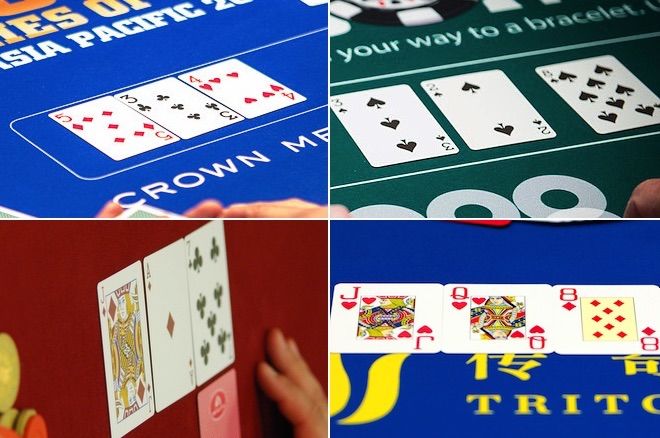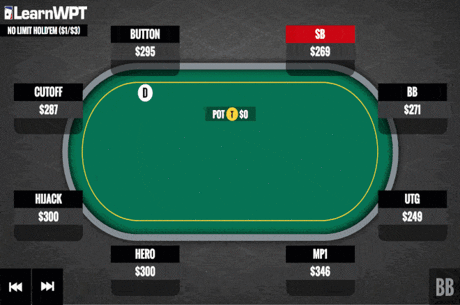Recognizing Different Flop Types in No-Limit Hold'em

Remember when you first learned how to play no-limit hold'em? What were the very first examples of strategy you learned?
After learning the rules and order of play, probably one of the first elements of the game you learned had to do with starting hand values. You learned how...
- A♦A♣, K♠K♥, A♣K♣, and Q♠Q♦ were best,
- A♣Q♦, A♦J♦, J♠10♠, 9♣9♠ were pretty good,
- Q♦J♣, 8♦6♦, 5♠4♠ were sometimes playable,
- and J♦2♣, 8♠3♥, and similar hands were junk.
From there you probably learned about the importance of position, bet sizing and pot odds, and other ideas related to postflop strategy. While you may have had help learning these concepts — from other players, by reading books and articles, or by watching instructional videos or televised poker — you probably picked up a lot of these things just by playing the game, using trial-and-error to appreciate how they work.
Along the way, many players indirectly begin to understand and appreciate differences between flop types. In fact, going back to that first lesson about starting hand values, players begin to realize that how a hand is affected by the flop has a lot to do with it being better or worse to play in the first place.
Hands like pocket aces and ace-king are good preflop, but tend to remain good after the flop, too. Those in-between hands like jack-ten suited can be good to play because of how flops improve their prospects. Meanwhile a junk hand like jack-deuce is unlikely to be helped by most flops, making it a poor starting hand.
The better no-limit hold'em players are able to think beyond how flops help or hurt their own hands. They also recognize how flops may or may not have helped their opponents, and play accordingly. Those who have gained more experience and advanced understanding of the game are able to recognize instinctively what are "good" or "bad" flops for everyone involved in the hand, often doing so in part by recognizing how flops fit certain categories of flop types.
Common flop types include:
- "high" flops containing two or three high cards (10x or higher)
- "low" flops with two or three low cards (8x or lower)
- "wet" flops with coordinated cards providing flush and/or straight draws (or made flushes or straights)
- "dry" flops with uncoordinated cards providing no draws
"High" and "low" flops are easy enough for players to recognize. So are "wet" and "dry" flops, although they might deserve a quick explanation.
A flop like 10♣9♥8♣ would be considered "wet" because of the way the three cards provide both a flush draw (to players holding two clubs in their hands), many different straight draws, and the possibility of a made straight. Any flop with two cards of the same suit and/or two cards of consecutive rank could be considered somewhat "wet."
Meanwhile a flop like Q♣7♦2♠ is "dry" because it offers very little as far as draws are concerned — nothing but "backdoor" draws, really, that need both the turn and river to be completed. "Dry" flops are usually also "rainbow" flops (with three different suits), ruling out flush draws.
Note how a "high" or "low" flop can either be "wet" or "dry" depending both on the suits and how close the rankings of the cards are.
Good players are able to draw lines between preflop action and the likelihood of these different types of flops improving players' hands.
A player showing strength preflop by raising from early position or three-betting is more likely to have a big pair or high cards than someone playing passively before the flop by calling others' raises. Thus a "high" and "dry" flop like A♣K♦8♠ is more apt to fit the preflop raiser/reraiser's range of hands, while a "low" and "wet" flop like 8♣7♣5♦ is likely more favorable to the passive player calling a raise from the blinds.
Being able to make this step — to recognize how preflop actions begin to suggest certain hands and then connect those actions to different flop types — goes a long way toward helping players improve their postflop decision-making.
There's another way of categorizing flops that some find helpful, one having to do with the amount of expected action a flop is likely to encourage. Ed Miller has written about this approach, using the terms "dynamic" and "static" to describe the different flop types.
A "dynamic" flop, explains Miller, is one that doesn't necessarily swing the advantage permanently in any player's direction, often leading to further play on the turn and/or river. Such flops are sometimes referred to as "action flops," given how they keep more players interested in continuing to battle for pots.
Meanwhile a "static" flop immediately swings the advantage to one player, discouraging others from going further with the hand. In the latter case, the player with the better hand on the flop will often look to earn value while those who missed the flop will usually look to minimize losses, thus leading to less postflop action.
Miller spells out this concept in his book The Course, explaining "that static flops are ones where hand rankings — yours and your opponents' — are unlikely to change much on the turn and river," while "dynamic flops are ones where hand rankings are likely to change significantly on the turn or river."
To give examples of each, "static" flops like K♣8♦3♠ or J♦4♣4♠ are ones that tend to ensure one player not only has the best hand on the flop, but that hand will continue to remain best on future streets. Having a king in your hand when the flop comes K♣8♦3♠ likely puts you ahead on the flop, and there are relatively few turn cards that will change that.
Meanwhile "dynamic" flops like 10♠9♣6♠ or 7♣5♠2♥ might immediately improve a player's hand, but they also are flops for which many different turn cards can change things dramatically. You aren't necessarily too comfortable when flopping top pair of tens when the board is 10♠9♣6♠, given how others with draws or overcards are going to continue to be interested going forward, and have good prospects for improving to hands that will beat yours.
As Miller points out, "high" and "dry" flops tend to be more "static," although not always. Meanwhile "low" and "wet" flops are often more "dynamic," but there are many exceptions there, too. The important point is not necessarily to be clever about categorizing flops, but to understand how best to proceed when faced with these different flop types.
For example, Miller notes how having position postflop is an even greater advantage when the flop is "dynamic." If you're out of position and the flop comes 10♠9♣6♠, you might not want to continuation bet if you were the preflop raiser, or if you weren't and you're drawing, you might want to play passive initially (check-calling) to avoid getting bet out of the hand. By contrast, "static" flops are safer, relatively speaking, for continuation bettors or for those looking to steal pots postflop with bluffs.
For more on Miller's "dynamic" versus "static" distinction, see his article "A Quick Way to Think About Flop Texture."
Figuring out how to connect players' preflop actions to different flops and deduce correctly whether or not flops are favorable to them is a much more complicated lesson to learn than was the earlier one regarding starting hand selection. But it's well worth the effort. Thinking in terms of different flop types or categories can be helpful as an initial step toward becoming more intelligent with postflop play.









